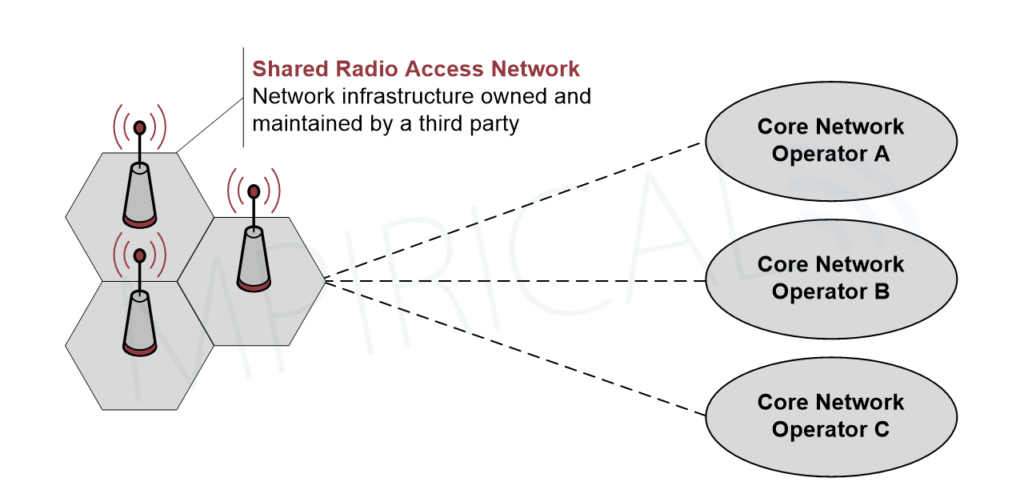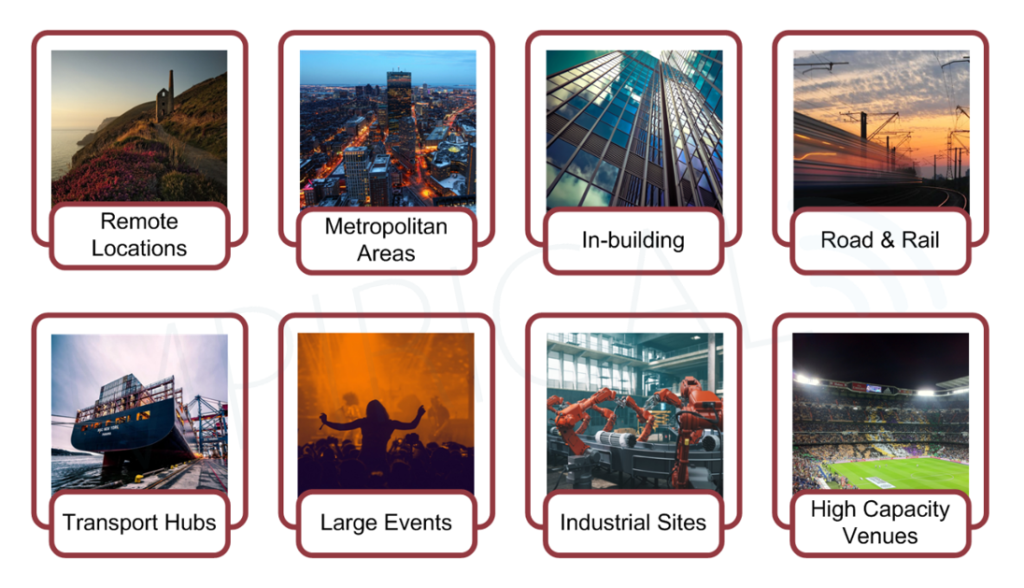
What is a Neutral Host Network?
Mitigating the costs of RAN deployment
In 5G, the capital cost of deploying the 5G NG-RAN is significant, particularly with higher frequency bands such as mmWave (Millimeter Wave), which will require significant investment in small cell deployments and much greater cell densification. One way that operators can mitigate these costs is through network-sharing agreements, in which the deployment and management of radio infrastructure can be shared between two or more operators.
Whilst traditional network sharing agreements such as MOCN (Multi-Operator Core Network) and MORAN (Multiple Operator Radio Access Network) are popular and bring benefits in terms of cost they also introduce further complexities in terms of management and coordination of resources.
NHNs (Neutral Host Networks) take this model a step further by allowing operators to outsource elements of the RAN to a third-party entity. In an NHN a 3rd party invests in RAN infrastructure and provides access to operators on a wholesale shared-tenant basis. The scale of NHNs can range from single-site small-cell deployments deployed by a site owner to large-scale RANs managed by dedicated solutions providers spanning a national area.
Network Sharing vs. Neutral Host Networks
An NHN (Neutral Host Network) is a shared and collaborative radio network infrastructure that allows multiple operators to utilize the same physical radio network assets, such as base stations, radio access equipment and backhaul while maintaining their distinct core network services. The term ‘neutral’ applies since these networks can be deployed and operated by a third party and provided on a wholesale basis to operators. This is different from network sharing where agreements are in place between operators to share elements of the RAN (Radio Access Network), however, the fundamentals of shared infrastructure remain the same, irrespective of the ownership model.

This concept arises from the increasing demand for mobile connectivity and the need to utilize network resources efficiently. Rather than each MSP deploying separate radio infrastructure, NHNs enable MSPs to share the same physical infrastructure, reducing CapEx (Capital Expenditure) and improving the overall efficiency of mobile communications. This approach not only optimizes resource utilization but also has the potential to drive competition in the telecommunications industry, providing consumers with greater choice, improved coverage, and higher quality of service.
Network Sharing: Passive vs. Active
Fundamentally, there are two types of network-sharing models: active and passive. Passive infrastructure sharing is the simplest of the two since it only involves the sharing of non-electronic infrastructure, for example, cell towers, poles, ducts, and the cell site itself. In passive network sharing, MSPs can co-locate their antennas and equipment on the same physical infrastructure, which helps reduce the overall cost of network deployment and maintenance. This is a popular approach since it allows the costs of site acquisition, maintenance, and power to be shared. It also requires no active coordination between providers.

Conversely, active sharing involves the sharing of not only passive infrastructure but also radio equipment, base stations, and other electronic components. This is more complex and requires a more closely coordinated approach between providers. MOCN, MORAN and GWCN are all examples of active sharing, and we will explore them in more detail later in this blog.
Transport Network Sharing
An additional area to consider in the field of Network Sharing is the challenge of ensuring sufficient transport network infrastructure is in place. This needs to evolve in parallel with the Radio Access Network itself, but as is the case with building a cell site, the cost of civil engineering related to installing fiber infrastructure is very high. If you couple this with the fact that more infrastructure is required when disaggregated RAN deployments are utilized, the business case of using a shared optical infrastructure is clear. This is not really a new concept; for many years, national fixed line incumbents have offered this service. However, with more providers rolling out localized or even national fiber deployments, the shared transport network market has the potential to become a lot more competitive.

Neutral Host Networks: Key Use Cases
Many use cases lend themselves to network sharing and neutral host solutions. One of the key driving factors is the need to address coverage challenges in remote areas, inside buildings and in high-density connectivity environments such as stadiums and festivals.

- Remote Locations – it may not always be economically viable for multiple operators to deploy radio infrastructure in remote locations where there are very few users. In this instance, it makes sense to utilize network sharing. This may be an arrangement where multiple operators share the RAN, and this is managed by a communications infrastructure provider, or the responsibility is shared among the operators. Governments around the world understand the limitations posed by remote locations and ubiquitous mobile coverage and as such, will often invest in neutral host infrastructure to address this.
- Metropolitan Areas – in heavily developed areas in large cities, small cell infrastructure can be deployed in street furniture such as signs and streetlamps to allow networks to deliver high data rates using higher frequencies. There are several examples worldwide where local municipal authorities are coordinating the deployment of this small-cell infrastructure to minimize its environmental impact and reduce visual clutter.
- In-building – in large office buildings, developers and management companies could be responsible for operating a local cellular deployment of small cells to provide indoor coverage in areas where coverage from an MSP is poor. DAS (Distributed Antenna System) is a common solution in this area.
- Road & Rail – whilst many road and rail users are generally well served in terms of coverage (depending on geography), particularly in built-up areas and above ground, there is still scope for increased capacity and coverage that could be met via a neutral host – this could be a railway operator in collaboration with an MSP for example. These networks can be used to provide coverage in areas such as underground railways and tunnels.
- Transport & Logistics Hubs – high-performing NHNs can be used to provide extended coverage and capacity in high-traffic areas such as airports. Again, this may be operated by the site owner either independently or in collaboration with MSPs.
- Large Events & High-Capacity Venues – this is likely to be competing with Wi-Fi, but venues may also collaborate with MSPs to ensure that a cell has the capacity to support a large number of users periodically. Venue owners may also choose to deploy their own small cell infrastructure which can be leased to MSPs.
- Industrial Sites – in a similar way to private cellular networks, NHNs can be deployed across multiple factories or industrial areas, creating shared infrastructure for real-time monitoring, automation, and communication in a variety of industries.
In summary, a Neutral Host Network is a Radio Access Network owned, maintained and operated by a third-party with access provided to Mobile Service Providers on a wholesale basis. This can range from small-cell deployments in high-capacity venues or in remote locations through to large-scale network infrastructure covering a regional or even a national area. This has the potential to reduce CapEx and rationalize the deployment of RAN infrastructure.
